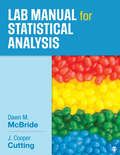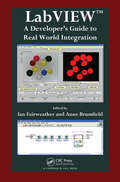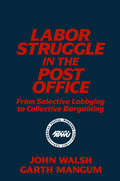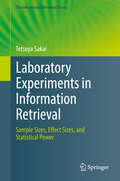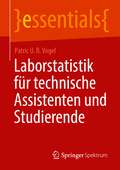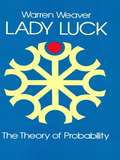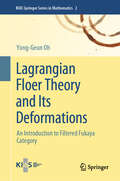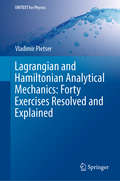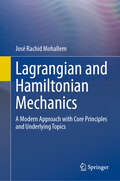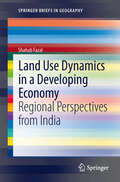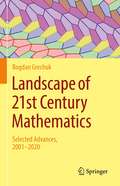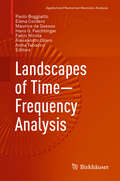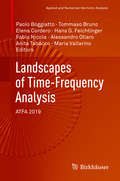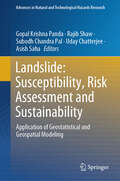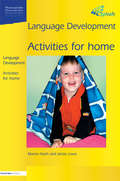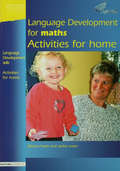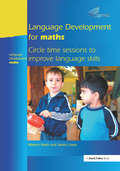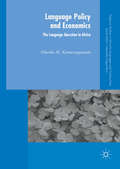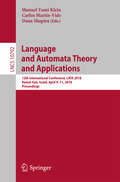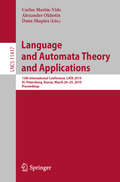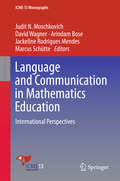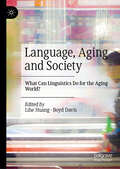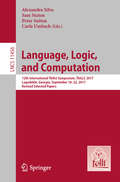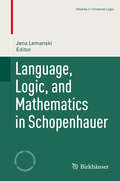- Table View
- List View
Lab Manual for Statistical Analysis
by J. Cooper Cutting Dawn M. McBridePacked with exercises, checklists, and how-to sections, this robust lab manual gives students hands-on guidance and practice for analyzing their own psychological research. The lab manual’s four sections include activities that correspond directly with the chapters of Dawn M. McBride’s The Process of Statistical Analysis in Psychology; activities related to data analysis projects (including data sets) that students can manipulate and analyze; activities designed to help students choose the correct test for different types of data; and exercises designed to help students write up results from analyses in APA style.
LabVIEW: A Developer's Guide to Real World Integration
by Ian Fairweather Anne BrumfieldLabVIEW™ has become one of the preeminent platforms for the development of data acquisition and data analysis programs. LabVIEW™: A Developer’s Guide to Real World Integration explains how to integrate LabVIEW into real-life applications.Written by experienced LabVIEW developers and engineers, the book describes how LabVIEW has been pivotal in solving real-world challenges. Each chapter is self-contained and demonstrates the power and simplicity of LabVIEW in various applications, from image processing to solar tracking systems. Many of the chapters explore how exciting new technologies can be implemented in LabVIEW to enable novel solutions to new or existing problems. The text also presents novel tricks and tips for integrating LabVIEW with third-party hardware and software.Ideal for LabVIEW users who develop stand-alone applications, this down-to-earth guide shows how LabVIEW provides solutions to a variety of application problems. It includes projects and virtual instrumentation for most of the programs and utilities described. Many of the authors’ own software contributions are available on the downloadable resources.
Labor Struggle in the Post Office: From Selective Lobbying to Collective Bargaining (Labor And Human Resources)
by John Walsh Garth L. MangumUsing data from the 2000 Census, this collection examines the major demographic and employment trends in the rural Midwestern states with special attention to the issues that state and local policy makers must address in the near future.
Laboratory Experiments in Information Retrieval: Sample Sizes, Effect Sizes, and Statistical Power (The Information Retrieval Series #40)
by Tetsuya SakaiCovering aspects from principles and limitations of statistical significance tests to topic set size design and power analysis, this book guides readers to statistically well-designed experiments. Although classical statistical significance tests are to some extent useful in information retrieval (IR) evaluation, they can harm research unless they are used appropriately with the right sample sizes and statistical power and unless the test results are reported properly. The first half of the book is mainly targeted at undergraduate students, and the second half is suitable for graduate students and researchers who regularly conduct laboratory experiments in IR, natural language processing, recommendations, and related fields.Chapters 1–5 review parametric significance tests for comparing system means, namely, t-tests and ANOVAs, and show how easily they can be conducted using Microsoft Excel or R. These chapters also discuss a few multiple comparison procedures for researchers who are interested in comparing every system pair, including a randomised version of Tukey's Honestly Significant Difference test. The chapters then deal with known limitations of classical significance testing and provide practical guidelines for reporting research results regarding comparison of means. Chapters 6 and 7 discuss statistical power. Chapter 6 introduces topic set size design to enable test collection builders to determine an appropriate number of topics to create. Readers can easily use the author’s Excel tools for topic set size design based on the paired and two-sample t-tests, one-way ANOVA, and confidence intervals. Chapter 7 describes power-analysis-based methods for determining an appropriate sample size for a new experiment based on a similar experiment done in the past, detailing how to utilize the author’s R tools for power analysis and how to interpret the results. Case studies from IR for both Excel-based topic set size design and R-based power analysis are also provided.
Laborstatistik für technische Assistenten und Studierende (essentials)
by Patric U. VogelIn diesem essential wird die Anwendung von statistischen Analysen von normalverteilten Daten im Laboralltag dargestellt. Hierzu zählen die Berechnung von Mittelwert und Standardabweichung sowie die Erstellung von einfachen grafischen Abbildungen. Im Anschluss werden Tests auf Ausreißer und Normalverteilung sowie Stichprobenberechnungen anhand einfacher Beispiele vorgestellt. Abschließend erlernen die Leser*innen den Vergleich von Datengruppen mittels t-test und ANOVA, das Erkennen von Zusammenhängen mittels linearer Regression und Korrelation sowie die Anwendung von Konfidenzintervallen. Zusätzlich werden übliche Fehlerquellen bei der Anwendung statistischer Methoden erklärt.
Lady Luck: The Theory of Probability
by Warren Weaver"Should I take my umbrella?" "Should I buy insurance?" "Which horse should I bet on?" Every day - in business, in love affairs, in forecasting the weather or the stock market questions arise which cannot be answered by a simple "yes" or "no." Many of these questions involve probability. Probabilistic thinking is as crucially important in ordinary affairs as it is in the most abstruse realms of science. This book is the best nontechnical introduction to probability ever written. Its author, the late Dr. Warren Weaver, was a professor of mathematics, active in the Rockefeller and Sloan foundations , an authority on communications and probability, and distinguished for his work at bridging the gap between science and the average citizen. In accessible language and drawing upon the widely diverse writings of thinkers like Kurt Godel, Susanne K.Langer, and Nicholas Bernoulli, Dr. Weaver explains such concepts as permutations, independent events, mathematical expectation, the law of averages, Chebychev's theorem, the law of large numbers, and probability distributions. He uses a probabilistic viewpoint to illuminate such matters as rare events and coincidences, and also devotes space to the relations of probability and statistics, gambling, and modern scientific research. Dr. Weaver writes with wit, charm and exceptional clarity. His mathematics is elementary, grasp of the subject profound, and examples fascinating. They are complemented by 49 delightful drawings by Peg Hosford. 13 tables. 49 drawings. Foreword. Index.
Lagrangian Floer Theory and Its Deformations: An Introduction to Filtered Fukaya Category (KIAS Springer Series in Mathematics #2)
by Yong-Geun OhA-infinity structure was introduced by Stasheff in the 1960s in his homotopy characterization of based loop space, which was the culmination of earlier works of Sugawara's homotopy characterization of H-spaces and loop spaces. At the beginning of the 1990s, a similar structure was introduced by Fukaya in his categorification of Floer homology in symplectic topology. This structure plays a fundamental role in the celebrated homological mirror symmetry proposal by Kontsevich and in more recent developments of symplectic topology.A detailed construction of A-infinity algebra structure attached to a closed Lagrangian submanifold is given in Fukaya, Oh, Ohta, and Ono's two-volume monograph Lagrangian Intersection Floer Theory (AMS-IP series 46 I & II), using the theory of Kuranishi structures—a theory that has been regarded as being not easily accessible to researchers in general. The present lecture note is provided by one of the main contributors to the Lagrangian Floer theory and is intended to provide a quick, reader-friendly explanation of the geometric part of the construction. Discussion of the Kuranishi structures is minimized, with more focus on the calculations and applications emphasizing the relevant homological algebra in the filtered context.The book starts with a quick explanation of Stasheff polytopes and their two realizations—one by the rooted metric ribbon trees and the other by the genus-zero moduli space of open Riemann surfaces—and an explanation of the A-infinity structure on the motivating example of the based loop space. It then provides a description of the moduli space of genus-zero bordered stable maps and continues with the construction of the (curved) A-infinity structure and its canonical models. Included in the explanation are the (Landau–Ginzburg) potential functions associated with compact Lagrangian submanifolds constructed by Fukaya, Oh, Ohta, and Ono. The book explains calculations of potential functions for toric fibers in detail and reviews several explicit calculations in the literature of potential functions with bulk as well as their applications to problems in symplectic topology via the critical point theory thereof. In the Appendix, the book also provides rapid summaries of various background materials such as the stable map topology, Kuranishi structures, and orbifold Lagrangian Floer theory.
Lagrangian and Hamiltonian Analytical Mechanics: Forty Exercises Resolved and Explained (UNITEXT for Physics)
by Vladimir PletserThis textbook introduces readers to the detailed and methodical resolution of classical and more recent problems in analytical mechanics. This valuable learning tool includes worked examples and 40 exercises with step-by-step solutions, carefully chosen for their importance in classical, celestial and quantum mechanics. The collection comprises six chapters, offering essential exercises on: (1) Lagrange Equations; (2) Hamilton Equations; (3) the First Integral and Variational Principle; (4) Canonical Transformations; (5) Hamilton – Jacobi Equations; and (6) Phase Integral and Angular FrequenciesEach chapter begins with a brief theoretical review before presenting the clearly solved exercises. The last two chapters are of particular interest, because of the importance and flexibility of the Hamilton-Jacobi method in solving many mechanical problems in classical mechanics, as well as quantum and celestial mechanics.Above all, the book provides students and teachers alike with detailed, point-by-point and step-by-step solutions of exercises in Lagrangian and Hamiltonian mechanics, which are central to most problems in classical physics, astronomy, celestial mechanics and quantum physics.
Lagrangian and Hamiltonian Mechanics: A Modern Approach with Core Principles and Underlying Topics
by José Rachid MohallemThis book serves as a textbook for an analytical mechanics course, a fundamental subject of physics, that pays special attention to important topics that are not discussed in most standard textbooks. Readers are provided with a clear understanding of topics that are usually inaccessible to the undergraduate level and that are critical to learning Lagrangian and Hamiltonian mechanics. Each chapter also includes worked problems and solutions, as well as additional exercises for readers to try. This book begins with the fundamentals of analytical mechanics, concisely introducing readers to the calculus of variations, Hamilton’s Principle, and Lagrange’s equations. While presenting readers with these core topics, the author uses an intuitive approach to delve into essential questions, such as where Galilean invariance lies in Lagrangian mechanics and how Hamilton’s Principle of Least Action encompasses Newton’s three laws, interesting conclusions that often go unnoticed. Infact, Hamilton’s principle is taken throughout as the very origin of classical physical laws, and the choice of appropriate Lagrangians in each case as the real theoretical challenge, meaning that forms of Lagrangian which differ from the standard one are not mere curiosities but, instead, the general rule. This book clarifies common misunderstandings that students face when learning the subject and formally rationalizes concepts that are often difficult to grasp. In addition, the final chapter provides an introduction to a Lagrangian field theory for those interested in learning more advanced topics. Ideal for upper undergraduate and graduate students, this book seeks to teach the intrinsic meaning of the principles and equations taught in an analytical mechanics course and convey their usefulness as powerful theoretical instruments of modern physics.
Lambda Calculus with Types
by Henk Barendregt Wil Dekkers Richard StatmanThe lambda calculus forms a prototype universal programming language, which in its untyped version is related to Lisp, and has been treated in the first author's classic The Lambda Calculus (1984). The formalism has since been extended with types and used in functional programming (Haskell, Clean) and proof assistants (Coq, Isabelle, HOL), which are used to design and verify IT products and mathematical proofs. In this book, the author focuses on three classes of typing for lambda terms: simple types, recursive types and intersection types. Unexpected mathematical beauty is revealed in these three formalisms of terms and types. Numerous exercises are provided to deepen the reader's understanding and increase their confidence using types.
Land Use Dynamics in a Developing Economy
by Shahab FazalToday, India still remains a rural agricultural country although the share of urban population has also increased but these figures do not tell the whole story. There are evidences that urban growth is dispersed and urban sprawl promotes the spread of urban land use into the rural-urban fringe. Here the attempt is to investigate the land transformation and the driving forces which were influencing the land transformation. The present study was done on peri urban interface of Aligarh city, a relatively small city, but as other north Indian cities, it is also expanding rapidly. Moreover, it too is surrounded by a populous rural area with productive and rich agricultural hinterland. Such conditions give rise to many conflicts and mutually beneficial complementarities in the rural and urban spheres. The result shows that the demand for land is high which results in informal urban development fulfilling the requirements of many of the city's residents. Every piece of land is a tradable commodity, and the pursuit of short-term profits is the predominant ethic. The actors in PUI are strong because it is characterized by intermixing of rural and urban activities and interests as well as the number of actors are greater than in any other area. .
Landscape of 21st Century Mathematics: Selected Advances, 2001–2020
by Bogdan GrechukLandscape of 21st Century Mathematics offers a detailed cross section of contemporary mathematics. Important results of the 21st century are motivated and formulated, providing an overview of recent progress in the discipline.The theorems presented in this book have been selected among recent achievements whose statements can be fully appreciated without extensive background. Grouped by subject, the selected theorems represent all major areas of mathematics: number theory, combinatorics, analysis, algebra, geometry and topology, probability and statistics, algorithms and complexity, and logic and set theory. The presentation is self-contained with context, background and necessary definitions provided for each theorem, all without sacrificing mathematical rigour. Where feasible, brief indications of the main ideas of a proof are given.Rigorous yet accessible, this book presents an array of breathtaking recent advances in mathematics. It is written for everyone with a background in mathematics, from inquisitive university students to mathematicians curious about recent achievements in areas beyond their own.
Landscapes of Time-Frequency Analysis (Applied and Numerical Harmonic Analysis)
by Anita Tabacco Paolo Boggiatto Elena Cordero Maurice De Gosson Hans G. Feichtinger Fabio Nicola Alessandro OliaroThe chapters in this volume are based on talks given at the inaugural Aspects of Time-Frequency Analysis conference held in Turin, Italy from July 5-7, 2017, which brought together experts in harmonic analysis and its applications. New connections between different but related areas were presented in the context of time-frequency analysis, encouraging future research and collaborations. Some of the topics covered include:Abstract harmonic analysis,Numerical harmonic analysis,Sampling theory,Compressed sensing,Mathematical signal processing,Pseudodifferential operators, andApplications of harmonic analysis to quantum mechanics.Landscapes of Time-Frequency Analysis will be of particular interest to researchers and advanced students working in time-frequency analysis and other related areas of harmonic analysis.
Landscapes of Time-Frequency Analysis: ATFA 2019 (Applied and Numerical Harmonic Analysis)
by Anita Tabacco Paolo Boggiatto Elena Cordero Hans G. Feichtinger Fabio Nicola Alessandro Oliaro Tommaso Bruno Maria VallarinoThis contributed volume features chapters based on talks given at the second international conference titled Aspects of Time-Frequency Analysis (ATFA 19), held at Politecnico di Torino from June 25th to June 27th, 2019. Written by experts in harmonic analysis and its applications, these chapters provide a valuable overview of the state-of-the-art of this active area of research. New results are collected as well, making this a valuable resource for readers seeking to be brought up-to-date. Topics covered include:Signal analysisQuantum theoryModulation space theoryApplications to the medical industryWavelet transform theoryAnti-Wick operatorsLandscapes of Time-Frequency Analysis: ATFA 2019 will be of particular interest to researchers and advanced students working in time-frequency analysis and other related areas of harmonic analysis.
Landslide: Application of Geostatistical and Geospatial Modeling (Advances in Natural and Technological Hazards Research #52)
by Rajib Shaw Uday Chatterjee Subodh Chandra Pal Gopal Krishna Panda Asish SahaThe book illustrates a geospatial and geostatistical approach to data analysis, modeling, risk assessment, and visualization, as well as landslide hazard management in the hilly region. This book investigates cutting-edge methodologies based on open source software and R statistical programming and modeling in current decision-making procedures, with a particular emphasis on recent advances in data mining techniques and robust modeling in torrential rainfall and earthquake induced landslide hazard.
Language Development 1a: Activities for Home
by Marion Nash Jackie LoweFirst Published in 2005. Routledge is an imprint of Taylor & Francis, an informa company.
Language Development for Maths: Activities for Home
by Marion Nash Jackie LoweBuilding upon the successful 'spirals' programme this series of books addresses language development in three core areas of the curriculum. Linking the work done in school with the simple games and activities to be used at home. All activities have been tried and tested - proven effectiveness. the video CD with teachers' book contains explanations and demonstrations of the programme and its implementation, with comments from the staff who have used it.
Language Development for Maths: Circle Time Sessions to Improve Communication Skills in Maths
by Marion Nash Jackie LoweBuilding on the successful 'spirals' programme this series of books addresses language development in the three core areas of the curriculum. Linking the work done in school with simple games and activities to be used at home. All activities have been tried and tested - proven effectiveness. A video CD contains explanation and demonstration of the programme and its implementation, with commetns from staff who have used it.
Language Policy and Economics: The Language Question in Africa
by Nkonko M. KamwangamaluThis book addresses the perennial question of how to promote Africa's indigenous languages as medium of instruction in educational systems. Breaking with the traditional approach to the continent's language question by focusing on the often overlooked issue of the link between African languages and economic development, Language Policy and Economics argues that African languages are an integral part of a nation's socio-political and economic development. Therefore, the book argues that any language policy designed to promote these languages in such higher domains as the educational system in particular must have economic advantages if the intent is to succeed, and proposes Prestige Planning as the way to address this issue. The proposition is a welcome break away from language policies which pay lip-service to the empowerment of African languages while, by default, strengthening the stranglehold of imported European languages.
Language and Automata Theory and Applications: 12th International Conference, Lata 2018, Ramat Gan, Israel, April 9-11, 2018, Proceedings (Lecture Notes in Computer Science #10792)
by Shmuel Tomi Klein Carlos Martín-Vide Dana ShapiraThis book constitutes the refereed proceedings of the 12th International Conference on Language and Automata Theory and Applications, LATA 2018, held in Ramat Gan, Israel, in April 2018.The 20 revised full papers presented together with 3 invited papers were carefully reviewed and selected from 58 submissions. The papers cover fields like algebraic language theory, algorithms for semi-structured data mining, algorithms on automata and words, automata and logic, automata for system analysis and programme verification, automata networks, automatic structures, codes, combinatorics on words, computational complexity, concurrency and Petri nets, data and image compression, descriptional complexity, foundations of finite state technology, foundations of XML, grammars (Chomsky hierarchy, contextual, unification, categorial, etc.), grammatical inference and algorithmic learning, graphs and graph transformation, language varieties and semigroups, language-based cryptography, mathematical and logical foundations of programming methodologies, parallel and regulated rewriting, parsing, patterns, power series, string processing algorithms, symbolic dynamics, term rewriting, transducers, trees, tree languages and tree automata, and weighted automata.
Language and Automata Theory and Applications: 13th International Conference, LATA 2019, St. Petersburg, Russia, March 26-29, 2019, Proceedings (Lecture Notes in Computer Science #11417)
by Carlos Martín-Vide Alexander Okhotin Dana ShapiraThis book constitutes the refereed proceedings of the 13th International Conference on Language and Automata Theory and Applications, LATA 2019, held in St. Petersburg, Russia, in March 2019. The 31 revised full papers presented together with 5 invited talks were carefully reviewed and selected from 98 submissions. The papers cover the following topics: Automata; Complexity; Grammars; Languages; Graphs, trees and rewriting; and Words and codes.
Language and Communication in Mathematics Education: International Perspectives (ICME-13 Monographs)
by David Wagner Judit N. Moschkovich Arindam Bose Jackeline Rodrigues Mendes Marcus SchütteThis book considers some of the outstanding questions regarding language and communication in the teaching and learning of mathematics – an established theme in mathematics education research, which is growing in prominence. Recent research has demonstrated the wide range of theoretical and methodological resources that can contribute to this area of study, including those drawing on cross-disciplinary perspectives influenced by, among others, sociology, psychology, linguistics, and semiotics. Examining language in its broadest sense to include all modes of communication, including visual and gestural as well as spoken and written modes, it features work presented and discussed in the Language and Communication topic study group (TSG 31) at the 13th International Congress on Mathematical Education (ICME-13). A joint session with participants of the Mathematics Education in a Multilingual and Multicultural Environment topic study group (TSG 32) enhanced discussions, which are incorporated in elaborations included in this book. Discussing cross-cutting topics it appeals to readers from a wide range of disciplines, such as mathematics education and research methods in education, multilingualism, applied linguistics and beyond.
Language, Aging and Society: What Can Linguistics Do for the Aging World?
by Lihe Huang Boyd DavisThis book explores how studies of language and aging can be applied to build an aging-friendly society, drawing on the socio-pragmatic turn in language and aging to examine the perspectives of older adults experiencing aging through a linguistic lens. Research on the phenomenon and mechanisms of language in aging can provide older adults with language training, increase their active aging, and offer improved information communication channels for an aging society, which will bring a series of clinical and social benefits to handle problems in aging and language across the world. This book will be of interest to researchers in linguistics, sociology, gerontology and related fields.
Language, Logic, and Computation: 12th International Tbilisi Symposium, TbiLLC 2017, Lagodekhi, Georgia, September 18-22, 2017, Revised Selected Papers (Lecture Notes in Computer Science #11456)
by Peter Sutton Alexandra Silva Sam Staton Carla UmbachThis book constitutes the refereed proceedings of the 12th International Tbilisi Symposium on Logic, Language and Computation, TbiLLC 2017, held in Lagodekhi, Georgia, in September 2017.The volume contains 17 full revised papers presented at the conference from 22 submissions. The aim of this conference series is to bring together researchers from a wide variety of fields in Natural language syntax, Linguistic typology, Language evolution, Logics for artificial intelligence and much more.
Language, Logic, and Mathematics in Schopenhauer (Studies in Universal Logic)
by Jens LemanskiThe chapters in this timely volume aim to answer the growing interest in Arthur Schopenhauer’s logic, mathematics, and philosophy of language by comprehensively exploring his work on mathematical evidence, logic diagrams, and problems of semantics. Thus, this work addresses the lack of research on these subjects in the context of Schopenhauer’s oeuvre by exposing their links to modern research areas, such as the “proof without words” movement, analytic philosophy and diagrammatic reasoning, demonstrating its continued relevance to current discourse on logic. Beginning with Schopenhauer’s philosophy of language, the chapters examine the individual aspects of his semantics, semiotics, translation theory, language criticism, and communication theory. Additionally, Schopenhauer’s anticipation of modern contextualism is analyzed. The second section then addresses his logic, examining proof theory, metalogic, system of natural deduction, conversion theory, logical geometry, and the history of logic. Special focus is given to the role of the Euler diagrams used frequently in his lectures and their significance to broader context of his logic. In the final section, chapters discuss Schopenhauer’s philosophy of mathematics while synthesizing all topics from the previous sections, emphasizing the relationship between intuition and concept. Aimed at a variety of academics, including researchers of Schopenhauer, philosophers, historians, logicians, mathematicians, and linguists, this title serves as a unique and vital resource for those interested in expanding their knowledge of Schopenhauer’s work as it relates to modern mathematical and logical study.
